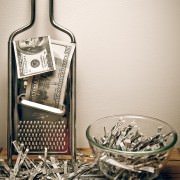5 Tools That Will Turn Your Restaurant Into a Data Expert
Thanks to a restaurant tech boom, the way consumers interact with restaurants is lightyears away from the SOP of 10-years ago. But full-service restaurants are still far behind their quick-service and fast-casual counterparts when it comes to adopting technology. New ways of operating like mobile ordering and payment, SMS and beacon marketing, crowd-sourcing and data, have been embraced the tightest by fast-food and quick-service chains that promote speed and convenience as a priority over a high-end service experience. But full-service restaurants are wrong to shun the tech boom. Restaurant operators maintaining outdated practices in the name of the tradition is putting their business at a disadvantage. It’s time full-service operators saw the benefits that come along with investing in technology for their restaurants. Here are 5 tools restaurants can use to better track and decipher their own data.
1. Data Helps You Understand Your Customers Better
Data isn’t just numbers, it’s information. And it’s information you can use to better understand your customers. Why is that important? Because knowing your customers better means knowing how, when, and why they spend their dollars at your restaurant.
It’s important to know this information. One great way restaurants can acquire and use data like this is to look at data from sources like OpenTable, interaction on social media, or through tools like Uncorkd iPad menus that can capture customer behavior in terms of item views and popularity
- Use technology that can track customer behavior: Utilize services that track customer data give you menu intelligence. iPad menus for restaurants track views and interaction on menus on multiple levels. Drilling down, you can get insight on an item-by-item level, or you can go higher and see menu views by wine varietal or beer type, and through different seasons and timelines.
- Employ an Interactive Social Media Strategy: Don’t just be active on social media. Create a social media strategy that allows you to learn from and interact with your customers. Create polls, surveys, contests,or crowd-source food specials and cocktails from your fans on social media. Social media marketing needs to be executed as strategy, not as an obligation.
2. Use Software That Helps Track Sales
TRACK YOUR SALES! The number of restaurant operators that don’t track their sales is surprising. For a business owner and operator, your sales and weekly PLO should be sacred text worn around the neck like an amulet.
It’s easier than ever now to track sales and turn that data into useful, actionable information. Tools like Upserve help track sales analytics, server performance, and the effectiveness of loyalty programs. This means you have a better grasp on the ROI for many aspects of your restaurant’s front-of-house.
- Track Sales and Reservations: Track reservation times, length of stay, and the sales at your peak time to understand how to better prepare and organize your restaurant to be maximize revenue at the busiest times.
3. Customer Contact Information is Key to Successful Restaurant Marketing
New technology has enhanced the way we communicate with one another. It’s important for restaurants, especially independent restaurants, to find ways they can communicate effectively with their customers.
Creating loyalty programs, mailing lists, and text message campaigns are all ways that will help you communicate with your customers to alert them to specials, events, new menus etc. and will benefit loyal customers with discounts for participation and advanced notice of unique and exciting promotions that they’ll want to take advantage.
- Create a customer loyalty program: Offer promotions and discounts to VIP customers in exchange for their contact information. But go one step further: offer on-the-spot incentives at sign up that can be instantly applied, like a percentage off their bill, or a free drink. The prospect of immediate gratification will entice people to sign up. Use their contact information as part of a direct marketing campaign through email or SMS to draw them back to the restaurant by alerting them about specials, promotions, events, and VIP benefits for their loyalty.
4. Use Scheduling Software to Track Labor
Dealing with labor cost analysis can cause headaches. But you no longer need to rely on your abacus to figure out the labor numbers that work for your bar or restaurant. Using scheduling software that helps track employee’s hours, costs, scheduling, and more, it’s much easier for you track labor information and glean insights faster on how to best staff your restaurant.
Remember, calculating labor as a percentage of sales isn’t the best strategy. There should be more variables to consider when looking at labor, and scheduling software can help consolidate that information, making it easier analyze, understand, and take action on.
- Hire Data-Minded Staff: When hiring new managers who will be responsible for scheduling staff at your restaurant, make sure they understand how to read and utilize data to make better decision. If they don’t have experience, make sure they at least understand the benefits of using data over guess work when it comes to decision that have a direct impact on your business expenses. As restaurants adopt more technology, they will have to take different skill sets into account when hiring the leaders of their restaurants.
5. Inventory Tracking Software with Intelligent Insights
Many restaurants don’t keep track of inventory. This includes food and alcohol. Dead stock on alcohol can really hurt a restaurant or bars liquor costs. If you’re aiming to run your beverage program at 20% cost, you need to make sure that you’re selling through the inventory you order on a regular basis.
There are many inventory apps like partender available to use in restaurants. But beyond software that makes it easier to perform the inventory, it’s important to be able to find insights from the data that help you run your beverage program better and manage costs.
There are many programs, like leanpath that help you manage food waste. Uncorkd has a whole article written about the benefits of tracking food and managing your waste. Food waste is just as costly for a restaurant as the theft and loss of alcohol is at the bar. From tracking serving sizes to utilizing produce and byproducts in the kitchen, tracking your food costs and where that food is going can help maximize your costs.
- 5 Fall Cocktails to Capture the Flavors of Autumn - September 26, 2018
- How Restaurants Can Ignore Sales and Increase Profits - May 9, 2018
- 2018 Spring Wine Trends - April 18, 2018









